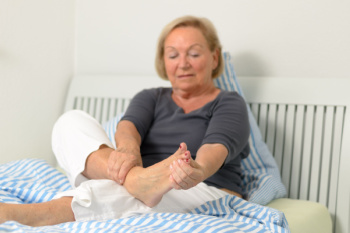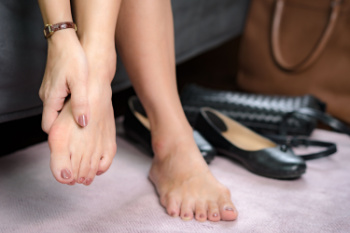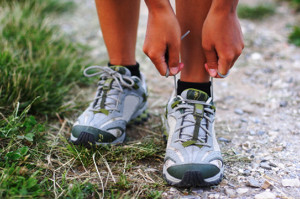Oceanside (760) 630-9200
March 2025
Heel Pain Can Be Treated!
What Is Mechanical Foot Pain and How Can You Treat It?

Mechanical foot pain is one of the most common reasons people visit a podiatrist. It happens when the structures in your feet, like bones, muscles, ligaments, or tendons, are strained or overworked. This type of pain often results from too much standing, walking, running, or wearing unsupportive shoes. Flat feet, high arches, and poor foot alignment can also lead to mechanical pain. You might feel aching, soreness, or sharp pain, usually in the heel, arch, or ball of the foot. The good news is that mechanical foot pain often improves with rest, wearing proper footwear, custom orthotics, stretching, and strengthening exercises. If foot pain is making it hard to get through your day, it is suggested that you visit a podiatrist who can diagnose the problem and help you find relief.
Foot Pain
Foot pain can be extremely painful and debilitating. If you have a foot pain, consult with Dr. Jeff Brooks from Oceanside Foot & Ankle Center. Our doctor will assess your condition and provide you with quality foot and ankle treatment.
Causes
Foot pain is a very broad condition that could be caused by one or more ailments. The most common include:
- Bunions
- Hammertoes
- Plantar Fasciitis
- Bone Spurs
- Corns
- Tarsal Tunnel Syndrome
- Ingrown Toenails
- Arthritis (such as Gout, Rheumatoid, and Osteoarthritis)
- Flat Feet
- Injury (from stress fractures, broken toe, foot, ankle, Achilles tendon ruptures, and sprains)
- And more
Diagnosis
To figure out the cause of foot pain, podiatrists utilize several different methods. This can range from simple visual inspections and sensation tests to X-rays and MRI scans. Prior medical history, family medical history, and any recent physical traumatic events will all be taken into consideration for a proper diagnosis.
Treatment
Treatment depends upon the cause of the foot pain. Whether it is resting, staying off the foot, or having surgery; podiatrists have a number of treatment options available for foot pain.
If you have any questions, please feel free to contact our office located in Oceanside, CA . We offer the newest diagnostic and treatment technologies for all your foot care needs.
Plantar Warts Can Be Treated!
Prevalence and Causes of Gout in Women

Although gout is often associated with men, it also affects women, particularly after menopause. Estrogen helps regulate uric acid levels, so its decline increases the risk of developing gout. The condition occurs when uric acid builds up in the bloodstream, forming painful crystals in the joints, including in the big toe. Risk factors include a diet high in purines, obesity, kidney disease, and certain medications that affect uric acid levels. Women with gout often experience symptoms in the toes, ankles, and knees, leading to swelling, redness, and severe pain. If left untreated, gout can cause joint damage and chronic pain, affecting mobility and quality of life. If you have pain in your big toe, it is suggested that you are under the care of a podiatrist who can provide an accurate diagnosis and treatment.
Gout is a painful condition that can be treated. If you are seeking treatment, contact Dr. Jeff Brooks from Oceanside Foot & Ankle Center. Our doctor will treat your foot and ankle needs.
What Is Gout?
Gout is a form of arthritis that is characterized by sudden, severe attacks of pain, redness, and tenderness in the joints. The condition usually affects the joint at the base of the big toe. A gout attack can occur at any random time, such as the middle of the night while you are asleep.
Symptoms
- Intense Joint Pain - Usually around the large joint of your big toe, and it most severe within the first four to twelve hours
- Lingering Discomfort - Joint discomfort may last from a few days to a few weeks
- Inflammation and Redness -Affected joints may become swollen, tender, warm and red
- Limited Range of Motion - May experience a decrease in joint mobility
Risk Factors
- Genetics - If family members have gout, you’re more likely to have it
- Medications - Diuretic medications can raise uric acid levels
- Gender/Age - Gout is more common in men until the age of 60. It is believed that estrogen protects women until that point
- Diet - Eating red meat and shellfish increases your risk
- Alcohol - Having more than two alcoholic drinks per day increases your risk
- Obesity - Obese people are at a higher risk for gout
Prior to visiting your podiatrist to receive treatment for gout, there are a few things you should do beforehand. If you have gout you should write down your symptoms--including when they started and how often you experience them, important medical information you may have, and any questions you may have. Writing down these three things will help your podiatrist in assessing your specific situation so that he or she may provide the best route of treatment for you.
If you have any questions, please feel free to contact our office located in Oceanside, CA . We offer the newest diagnostic and treatment technologies for all your foot care needs.
Arthritis Can Cause Pain in the Feet and Ankles
Bunions Worsen With Age and Are More Common in Women

Bunions tend to worsen over time and are more prevalent in women due to a combination of genetic, structural, and footwear-related factors. Aging weakens connective tissues, leading to joint instability and increased toe misalignment. Women are particularly at risk because of shoes with narrow toe boxes and high heels, which place excessive pressure on the forefoot and push the big toe out of alignment. Hormonal changes may also contribute by affecting ligament flexibility. As bunions progress, they can cause pain, swelling, and difficulty walking. Choosing supportive, wide-toe shoes and avoiding prolonged use of restrictive footwear can help slow progression. Strengthening foot muscles with targeted exercises may also provide relief. For persistent discomfort or severe deformity, it is suggested that you see a podiatrist who can offer personalized solutions, including orthotics, padding, or surgical options to improve comfort and function as the condition advances.
If you are suffering from bunion pain, contact Dr. Jeff Brooks of Oceanside Foot & Ankle Center. Our doctor can provide the care you need to keep you pain-free and on your feet.
What Is a Bunion?
Bunions are painful bony bumps that usually develop on the inside of the foot at the joint of the big toe. As the deformity increases over time, it may become painful to walk and wear shoes. Women are more likely to exacerbate existing bunions since they often wear tight, narrow shoes that shift their toes together. Bunion pain can be relieved by wearing wider shoes with enough room for the toes.
Causes
- Genetics – some people inherit feet that are more prone to bunion development
- Inflammatory Conditions - rheumatoid arthritis and polio may cause bunion development
Symptoms
- Redness and inflammation
- Pain and tenderness
- Callus or corns on the bump
- Restricted motion in the big toe
In order to diagnose your bunion, your podiatrist may ask about your medical history, symptoms, and general health. Your doctor might also order an x-ray to take a closer look at your feet. Nonsurgical treatment options include orthotics, padding, icing, changes in footwear, and medication. If nonsurgical treatments don’t alleviate your bunion pain, surgery may be necessary.
If you have any questions, please feel free to contact our office located in Oceanside, CA . We offer the newest diagnostic and treatment technologies for all your foot care needs.
Gout Pain Can Be Managed
Trail Running Shoes for Optimal Performance

Trail running shoes are designed for off-road running, offering essential features to enhance performance and comfort. One key feature is waterproofing, which helps keep feet dry in wet conditions, preventing discomfort and blisters during rainy runs or when crossing streams. For runners with wider feet, wide-fit trail running shoes provide extra space, ensuring a more comfortable fit and reducing pressure on the toes. Mud shoes are another important type of trail running shoe, equipped with specialized traction to handle slippery and muddy trails. These shoes typically have deeper treads that provide better grip and stability, preventing slips. Whether running through wet terrain, navigating rocky paths, or tackling muddy routes, the right trail running shoes ensure durability, support, and comfort for every adventure. If you have sustained a foot injury while trail running, it is suggested that you consult a podiatrist who can offer effective relief tips, and guide you on the correct shoes to wear.
You should always make sure your running shoes fit properly in order to avoid injury. For more information, contact Dr. Jeff Brooks from Oceanside Foot & Ankle Center. Our doctor can provide the care you need to keep you pain-free and on your feet.
Choosing the Right Running Shoe for Your Foot Type
Improper shoe sizing can cause a myriad of problems for your feet. Shoes that don’t fit you properly can lead to muscular imbalances in your body, which can result in foot, knee, and hip injuries.
Tips for Finding the Right Running Shoe
- Make sure you have a thumb’s width of wiggle room between the end of your longest toe and the front of the shoe.
- There should be little to no slipping at the heel
- Don’t assume your size in one shoe brand will be your size in another
- Do not lace up your shoes too tightly
- Walk around in the store with your new shoes before you buy them
If you have any questions please feel free to contact our our office located in Oceanside, CA . We offer the newest diagnostic and treatment technologies for all your foot and ankle needs.









